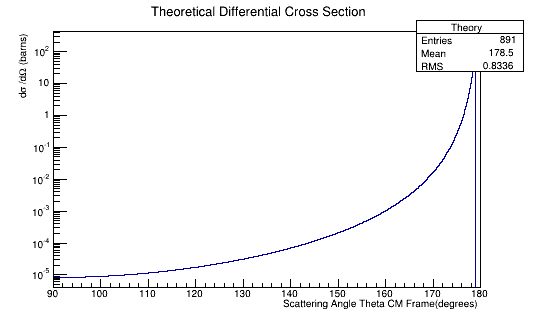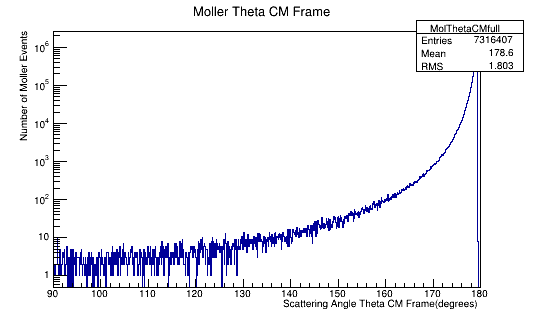Difference between revisions of "Converting to barns"
| (23 intermediate revisions by the same user not shown) | |||
| Line 1: | Line 1: | ||
| − | Using the equation from | + | <center><math> \underline{\textbf{Navigation} }</math> |
| + | |||
| + | [[Uniform_distribution_in_Energy_and_Theta_LUND_files|<math>\vartriangleleft </math>]] | ||
| + | [[VanWasshenova_Thesis#Moller_Scattering|<math>\triangle </math>]] | ||
| + | [[Relativistic_Units|<math>\vartriangleright </math>]] | ||
| + | |||
| + | </center> | ||
| + | |||
| + | Using the equation from Landau and Lifshitz(Quantum Electrodynamics Volume 4) | ||
<center><math>\frac{d\sigma}{d\Omega}=\frac{ e^4 }{8E^2}\left \{\frac{1+cos^4\frac{\theta}{2}}{sin^4\frac{\theta}{2}}+\frac{1+sin^4\frac{\theta}{2}}{cos^4\frac{\theta}{2}}+\frac{2}{sin^2\frac{\theta}{2}cos^2\frac{\theta}{2}} \right \}</math></center> | <center><math>\frac{d\sigma}{d\Omega}=\frac{ e^4 }{8E^2}\left \{\frac{1+cos^4\frac{\theta}{2}}{sin^4\frac{\theta}{2}}+\frac{1+sin^4\frac{\theta}{2}}{cos^4\frac{\theta}{2}}+\frac{2}{sin^2\frac{\theta}{2}cos^2\frac{\theta}{2}} \right \}</math></center> | ||
| Line 7: | Line 15: | ||
| − | + | For ultra-relativistic particles, this can be simplified to the form | |
<center><math>\frac{d\sigma}{d\Omega}=\frac{ \alpha^2 }{4E^2}\frac{ (3+cos^2\theta)^2}{sin^4\theta}</math></center> | <center><math>\frac{d\sigma}{d\Omega}=\frac{ \alpha^2 }{4E^2}\frac{ (3+cos^2\theta)^2}{sin^4\theta}</math></center> | ||
| − | Plugging in the values expected for a scattering electron: | + | Plugging in the values expected for a scattering electron in the CM frame: |
| Line 25: | Line 33: | ||
Using unit analysis on the term outside the parantheses, we find that the differential cross section for an electron at this momentum should be around | Using unit analysis on the term outside the parantheses, we find that the differential cross section for an electron at this momentum should be around | ||
| − | <center><math>\frac{5.3279\times 10^{-5}}{4\times 2.81\times 10^{15}eV^2}=4.74\times 10^{-21} eV^{-2}=\frac{4.74\times 10^{-21}}{1eV^2}\times \frac{1\times 10^{18}eV^2 }{1\ GeV^2}=\frac{.0047}{GeV^2}</math></center> | + | <center><math>\frac{5.3279\times 10^{-5} }{4\times (53\times 10^6\ eV)^2}=\frac{5.3279\times 10^{-5}}{4\times 2.81\times 10^{15}eV^2}=4.74\times 10^{-21} eV^{-2}=\frac{4.74\times 10^{-21}}{1eV^2}\times \frac{1\times 10^{18}eV^2 }{1\ GeV^2}=\frac{.0047}{GeV^2}</math></center> |
Using the conversion of | Using the conversion of | ||
| Line 34: | Line 42: | ||
<center><math>\frac{1\ GeV^{-2}}{.3894\ mb}=\frac{.0047\ GeV^{-2}}{x\ mb}</math></center> | <center><math>\frac{1\ GeV^{-2}}{.3894\ mb}=\frac{.0047\ GeV^{-2}}{x\ mb}</math></center> | ||
| + | |||
| + | |||
| + | <center><math>\rightarrow x=\frac{.0047\ GeV^{-2}.3894\ mb}{1\ GeV^{-2}}=1.8\times 10^{-6} b</math></center> | ||
| + | |||
| + | |||
The trigonometric function part of the equation comes out to it's minimum of 9 at 90 degrees. | The trigonometric function part of the equation comes out to it's minimum of 9 at 90 degrees. | ||
| Line 46: | Line 59: | ||
| − | [[File: | + | [[File:Theory179cutoff.png|frame|center|alt=Theoretical Moller Differential Cross-Section in Center of Mass Frame Frame|'''Figure 5a:''' The theoretical Moller electron differential cross-section for an incident 11 GeV(Lab) electron in the Center of Mass frame of reference.]] |
Converting the number of electrons scattered per angle theta to barns, we can use the relation | Converting the number of electrons scattered per angle theta to barns, we can use the relation | ||
| − | <center><math>L=\frac{ | + | <center><math>L=\frac{N_{scattered}}{t \sigma} \approx I_{beam}\times \rho_{target}\times l_{target}</math></center> |
| + | |||
| + | |||
| + | <center><math>\frac{N_{scattered}}{ \sigma} \approx N_{incident}\times \rho_{target}\times l_{target}</math></center> | ||
| + | |||
| + | |||
| + | |||
| + | where ρ<sub>target</sub> is the density of the target material, l<sub>target</sub> is the length of the target, and I<sub>scattered</sub> is the number of incident particles scattered per time. | ||
| + | |||
| + | This gives, for LH2 in a 5cm long target in the Lab Frame, or in the CM frame: | ||
| + | |||
| + | |||
| + | <center><math>z'=\gamma (z-vt)</math></center> | ||
| + | |||
| + | |||
| + | |||
| + | |||
| + | <center><math>z=5cm</math></center> | ||
| + | |||
| + | |||
| + | and <math>\beta^2 \equiv \frac{v^2}{c^2}=\frac{p^2c^2}{m^2c^2c^2}=\frac{p^2c^2}{E^2}=\frac{p^2}{E^2}</math> | ||
| + | |||
| + | with <math>c=1</math> | ||
| + | |||
| + | and <math>\gamma \equiv \frac{1}{\sqrt{1-\beta^2}}=\frac{E}{\sqrt{E^2}\sqrt{1-\frac{p^2}{E^2}}}=\frac{E}{m}</math> | ||
| + | |||
| + | Where <center><math>E^2=p^2+m^2=(11000\ MeV)^2+(0.511\ MeV)^2 \rightarrow E=11000\ MeV</math></center> | ||
| − | + | <math>\gamma=\frac{E}{m}=\frac{11000\ MeV}{0.511\ MeV}=21526</math> | |
| − | |||
| − | + | <math>z'=\frac{1}{\gamma}z=\frac{1}{21526}5\ cm=2.32\times 10^{-4}\ cm</math> | |
| − | |||
| − | <center><math>\frac{1}{\rho_{target}\times l_{target} \times | + | <center><math>\rho_{target}\times l_{target}=\frac{70.85 kg}{1 m^3}\times \frac{1 mole}{2.02 g} \times \frac{1000g}{1 kg} \times \frac{6\times10^{23} atoms}{1 mole} \times \frac{1m^3}{(100 cm)^3} \times \frac{0.05 cm}{ } \times \frac{10^{-24} cm^{2}}{barn} =1.05\times 10^{-3} barns^{-1}</math></center> |
| + | |||
| + | |||
| + | Using the number of incident electrons, for 1 Moller electron: | ||
| + | |||
| + | <center><math>\frac{1}{\rho_{target}\times l_{target} \times 6\times 10^7}=1.58\times 10^{-5} barns</math></center> | ||
We can use this number to scale the number of electrons per angle to a differential cross-section in barns. Using the plot of the Moller electron scattering angle theta in the Center of Mass frame, | We can use this number to scale the number of electrons per angle to a differential cross-section in barns. Using the plot of the Moller electron scattering angle theta in the Center of Mass frame, | ||
| − | [[File: | + | [[File:6e7MolThetaCM.png|frame|center|alt=Moller Electron Angle Theta in Center of Mass Frame|'''Figure 5b:''' The Moller electron scattering angle theta distribution for an incident 11 GeV(Lab) electron in the Center of Mass frame of reference.]] |
| Line 71: | Line 113: | ||
<pre> | <pre> | ||
TH1F *Combo=new TH1F("TheoryExperiment","Theoretical and Experimental Differential Cross-Section CM Frame",360,90,180); | TH1F *Combo=new TH1F("TheoryExperiment","Theoretical and Experimental Differential Cross-Section CM Frame",360,90,180); | ||
| − | Combo->Add(MollerThetaCM, | + | Combo->Add(MollerThetaCM,7.92e-7); |
Combo->Draw(); | Combo->Draw(); | ||
Theory->Draw("same"); | Theory->Draw("same"); | ||
| Line 78: | Line 120: | ||
---- | ---- | ||
| − | + | <center><math> \underline{\textbf{Navigation} }</math> | |
| + | |||
| + | [[Uniform_distribution_in_Energy_and_Theta_LUND_files|<math>\vartriangleleft </math>]] | ||
| + | [[VanWasshenova_Thesis#Moller_Scattering|<math>\triangle </math>]] | ||
| + | [[Relativistic_Units|<math>\vartriangleright </math>]] | ||
| − | + | </center> | |
Latest revision as of 17:54, 29 December 2018
Using the equation from Landau and Lifshitz(Quantum Electrodynamics Volume 4)
For ultra-relativistic particles, this can be simplified to the form
Plugging in the values expected for a scattering electron in the CM frame:
Using unit analysis on the term outside the parantheses, we find that the differential cross section for an electron at this momentum should be around
Using the conversion of
The trigonometric function part of the equation comes out to it's minimum of 9 at 90 degrees.
We find that the differential cross section scale is
Plotting the Moller Differential Cross-Section we find:
Converting the number of electrons scattered per angle theta to barns, we can use the relation
where ρtarget is the density of the target material, ltarget is the length of the target, and Iscattered is the number of incident particles scattered per time.
This gives, for LH2 in a 5cm long target in the Lab Frame, or in the CM frame:
and
with
and
Where
Using the number of incident electrons, for 1 Moller electron:
We can use this number to scale the number of electrons per angle to a differential cross-section in barns. Using the plot of the Moller electron scattering angle theta in the Center of Mass frame,
We can rescale and combine the theoretical differential cross-section for one electron.
TH1F *Combo=new TH1F("TheoryExperiment","Theoretical and Experimental Differential Cross-Section CM Frame",360,90,180);
Combo->Add(MollerThetaCM,7.92e-7);
Combo->Draw();
Theory->Draw("same");

